The Bolivian heart of palm
Lets learn together
The Palmito is mainly cultivated in the tropics of Bolivia’s Cochabamba, within the municipalities of Chimoré, Shinahota, Villa Tunari, Puerto Villarroel, and to a lesser extent, in the department of Santa Cruz. Covering an area of 6,500 hectares, the current production capacity is estimated between 20 and 25 million stems of heart of palm per year, with an average yield between 3,000 and 3,500 stems per hectare annually.
The first introduction of this cultivable species in the tropical region of Cochabamba took place at the end of the decade in the 70s. Following the year of 1992, a series of programs and projects to support the production of Palmito as a crop was established for the economy of tropical farmers. Currently, small and medium-sized producers have formed associations, in some cases becoming participants in the industrialization of packaged hearts of palm.
In addition to the private enterprises, the Government of the Plurinational State of Bolivia, through the Agency INSUMOS Bolivia, invested in the construction of two Palmito processing plants in the communities of Shinahota and Ivirgarzama in the Tropics of Cochabamba. In this way, it has been possible to benefit the small farmers dedicated to this area, who received an unacceptable amount of small pay for their production, which in contrast, was sold at good prices in the foreign market.
At the same time with these industries, there has been an impact on the generation and availability of employment in the region mainly aimed at young people, women and single mothers. This focused on the sectors that are more discriminated against and with fewer possibilities of having access to work. On the other hand, since the production of the INSUMOS Bolivia plants is destined both to the foreign market and to be part of the Prenatal and Lactation Subsidy and other social programs, it has allowed more families to access this food, which was conventionally consumed by people with high purchasing power.
Palm heart exports
Know our work
Exported value
In the period between 2006 and 2016, Bolivian palm heart exports reached a total value of 136.35 million US dollars, presenting a growth rate of 61% compared to 2006.
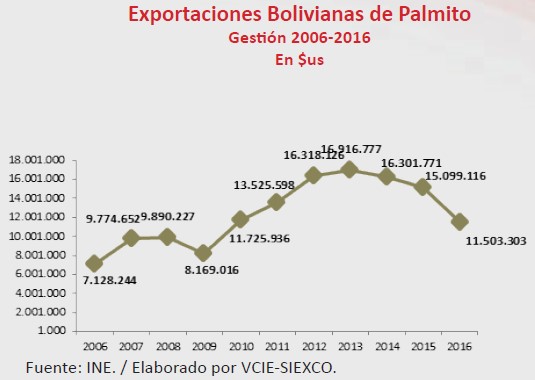
Exported volume
In the last 11 years, the exported volume of Bolivian heart of palm was 70,455 Metric Tons, with a growth rate of 48.6% compared to 2006. The highest exported volume was recorded during 2013, reaching 8313 metric tons.
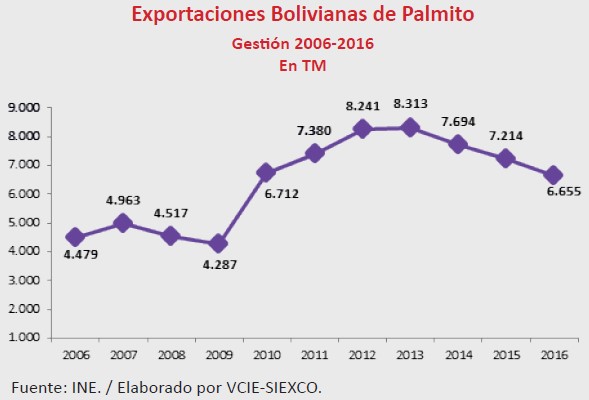
Average FOB price
During 2016, the average FOB price of palm hearts was 1,962 $ US / MT. In this management, five countries (Argentina, Chile, Uruguay, Paraguay and Lebanon) traded below the average FOB price. However, other destinations such as the United States, Morocco, Canada, Venezuela and Spain, priced the product at levels above said average.
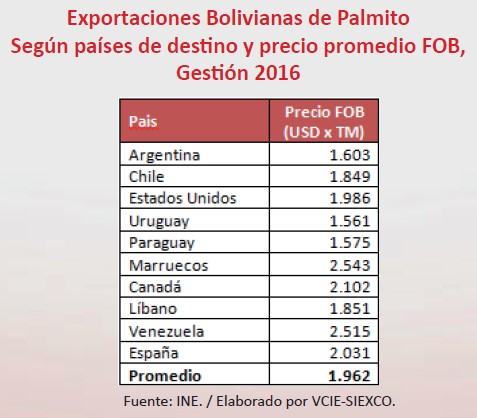
Destination Markets
Argentina is the main destination for Bolivian heart of palm exports, with 40.4% of the total value exported in the period 2006 - 2016. Chile is the second destination for Bolivian heart of palm, with 27.2% for the same period . On the other hand, Uruguay is presented as an attractive market since in 2016 it exported six times more than in 2006. Even in 2013 it exceeded exports to the United States.

Exports by department
Learn more about us
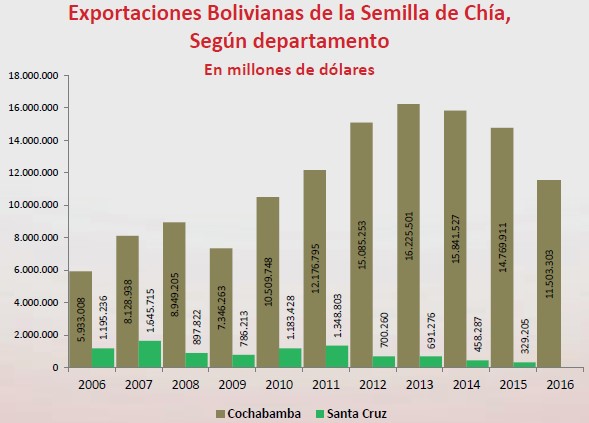
Exported value
In the period spanning the last 11 years, that is, from 2006 to 2016, 93% of Bolivian palm heart exports came from the department of Cochabamba, with the remaining 7% coming from the department of Santa Cruz.
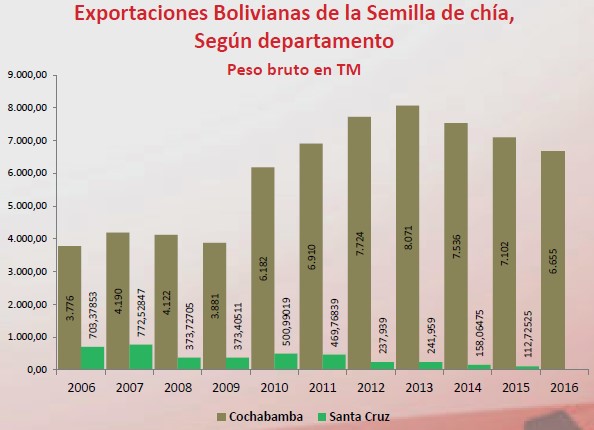
Exported volume
An analysis of the last two years has shown that the production of Cochabamba obtained greater preponderance being that by 2015, 98% of the exported hearts of palm originated in the department of Cochabamba and by the next year all exported hearts of palm came from this Department.
 Boris R. Cuevas C.
Boris R. Cuevas C.